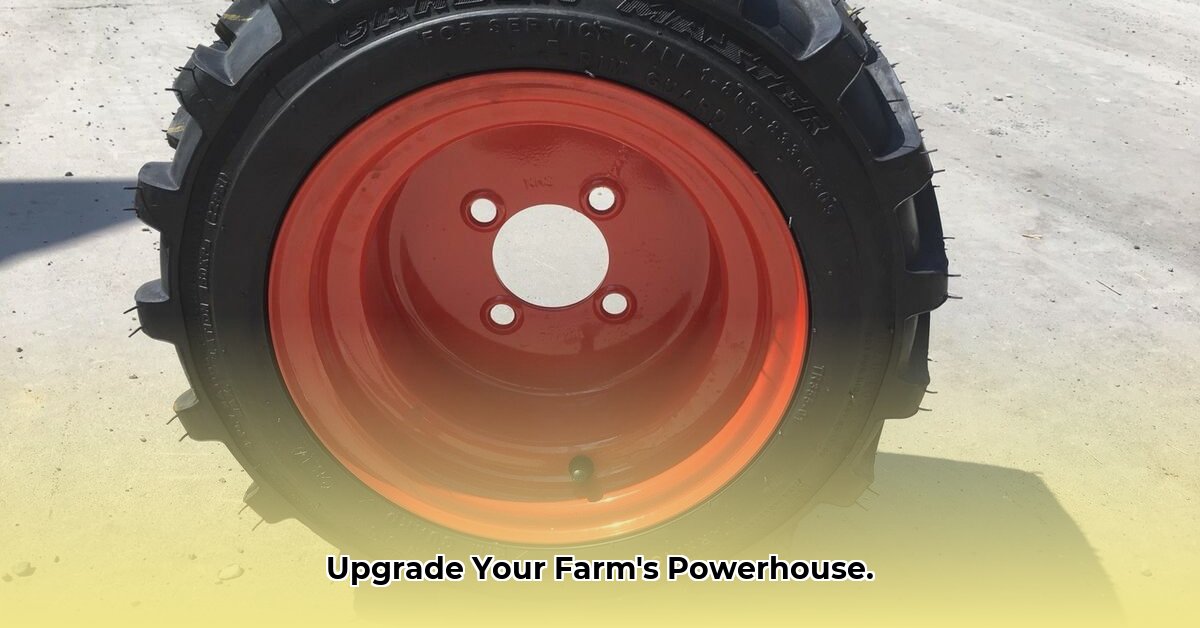
Choosing the right front tires for your Kubota tractor is crucial for maximizing efficiency and minimizing long-term costs. This guide will help you navigate the decision-making process, from understanding your specific needs to responsible tire disposal. For optimal tire pressure, check out this helpful resource on tire pressure.
Understanding Your Needs: A Foundation for Success
Before selecting tires, assess your farm's unique requirements. Soil type (clay, sandy loam, etc.) significantly impacts traction and compaction. Your farming practices (no-till vs. conventional tillage) also influence tire selection. Heavier workloads demand higher load-capacity tires. For example, consistently muddy conditions necessitate aggressive tread patterns for maximum grip, whereas primarily paved road use prioritizes smooth treads for longevity and comfort. Carefully consider these factors to ensure optimal tire performance. What are your specific soil and operational challenges?
Key Tire Specifications & Technologies: Demystifying the Details
Kubota tractor front tires are primarily available in two constructions: radial and bias-ply. Radial tires generally offer better fuel efficiency and a smoother ride, making them a popular choice. Bias-ply tires are typically tougher and more durable and are a better fit for extremely rough terrain. However, they usually are less fuel-efficient. Tread patterns vary, with deeper treads providing superior traction in muddy conditions, while shallower treads are better suited for paved surfaces. The rubber compound impacts durability and traction; tougher compounds extend lifespan but might slightly reduce traction. Load capacity is critical; ensure your selected tires can consistently handle your tractor's weight and implements. Proper inflation pressure is paramount: it affects fuel efficiency, soil compaction, and tire longevity.
Assessing Kubota Front Tire Options: Finding the Ideal Match
Kubota offers a range of front tire options. Here's a structured approach to selecting the best fit for your operation:
Research: Thoroughly review Kubota's tire specifications, focusing on load capacity, tread pattern, and construction type. (Radial tires generally offer better fuel economy and a smoother ride, while bias-ply tires are typically tougher and more durable).
Consult Experts: Engage your local Kubota dealer or a tire specialist. They can offer personalized recommendations based on your specific farming needs and soil conditions. Their expertise is invaluable.
Comparative Analysis: While comprehensive comparisons of all Kubota models are challenging to find, utilize independent reviews and test results to inform your decision-making process.
Budgetary Considerations: Factor in initial cost, projected lifespan, fuel-efficiency gains, and potential long-term savings when evaluating different tire options. A comprehensive cost-benefit analysis should be performed.
Cost-Benefit Analysis & Long-Term Planning: A Holistic Perspective
While initial cost is a factor, long-term implications are paramount.
Fuel Efficiency: Fuel-efficient tires, even if more expensive upfront, can yield significant fuel savings over their lifespan, especially with rising fuel prices. Are you aware of your current fuel consumption?
Soil Compaction: Improper tire selection and inflation can lead to soil compaction, negatively affecting crop yields and soil health. Proper inflation and appropriate tires minimize compaction, improving long-term productivity. How critical is soil health to your farming practices?
Tire Longevity: Durable tires reduce replacement frequency, saving both money and downtime. A longer tire lifespan directly impacts operational efficiency and long-term profitability.
Maintenance & Disposal: Responsible Tire Management
Proper maintenance is key to extending tire life and minimizing environmental impact.
Inflation: Regularly check and adjust tire pressure to the manufacturer's recommendations. Underinflation increases wear and tear, while overinflation can damage the tire and increase compaction.
Inspection: Regularly inspect tires for wear, cuts, punctures, or unusual wear patterns. Early detection prevents larger, costlier repairs.
Disposal: Dispose of old tires responsibly. Utilize recycling programs offered by tire dealers or waste management facilities to respect the environment. What are the recycling options available in your area?
Conclusion: Optimizing Farm Efficiency Through Informed Tire Selection
Choosing the right Kubota tractor front tires involves a multifaceted evaluation of your farm's unique needs and long-term goals. By carefully considering soil type, farming practices, workload, and tire specifications, you can make an informed decision that enhances efficiency, minimizes costs, and promotes environmental sustainability. Remember, investing in high-quality tires is investing in the long-term success of your operation.